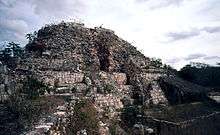List of Maya sites
This list of Maya sites is an alphabetical listing of a number of significant archaeological sites associated with the Maya civilization of pre-Columbian Mesoamerica.
The peoples and cultures which comprised the Maya civilization spanned more than 2500 years of Mesoamerican history, in the region of southern Mesoamerica which incorporates the present-day nations of Guatemala and Belize, much of Honduras and El Salvador, and the southeastern states of Mexico from the Isthmus of Tehuantepec eastwards, including the entire Yucatán Peninsula.
Throughout this region, many hundreds of Maya sites[1] have been documented in at least some form by archaeological surveys and investigations, while the numbers of smaller/uninvestigated (or unknown) sites are so numerous (one study has documented over 4,400 Maya sites)[2] that no complete archaeological list has yet been made. The listing which appears here is necessarily incomplete, however it contains notable sites drawn from several large and ongoing surveys, such as the Corpus of Maya Hieroglyphic Inscriptions (CMHI) and other sources (see References).
- Note : Ignore the Spanish definite article "El" or "La" (and their plurals "Los" and "Las") when looking for a site in the alphabetical listing e.g. for El Mirador, look under M rather than E.

 |
| Maya civilization |
|---|
| History |
| Preclassic Maya |
| Classic Maya collapse |
| Spanish conquest of the Maya |
Most important sites
Maya sites which are known to have been among the largest and most influential polities through the various eras of Maya history —Formative (or Preclassic), Classic and Postclassic— and/or which have left the most impressive archaeological remains include:
| Site | Location | Description | Photo |
|---|---|---|---|
| El Baúl | Escuintla Department, Guatemala | El Baúl, along with the sites of Bilbao and El Castillo, forms the Cotzumalhuapa Nuclear Zone, a large urban area dating to the Late Classic period. | 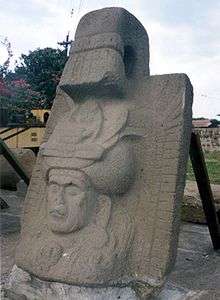 |
| Becan | Campeche, Mexico | Becan was a major city in the Yucatán Peninsula. It was occupied from about 550 BC, in the Middle Preclassic period and was inhabited through the entire Classic Period, finally being abandoned around the 9th century AD. The site had contact with Teotihuacan in the Early Classic and was fortified with a moat and ramparts.[3] |  |
| Calakmul | Campeche, Mexico | Calakmul was one of the two most important Maya cities in the Classic Period, when its rivalry with Tikal dominated the Maya political landscape. The city was already an important city in the Late Preclassic, with dated monuments being erected up to the beginning of the 10th century AD.[4] | 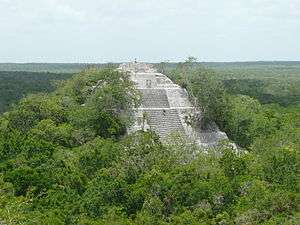 |
| Caracol | Cayo District, Belize | Caracol was an important lowland Maya city, it was already settled in the Late Preclassic but reached its maximum power in the Classic Period when it was first allied with Tikal and later with Calakmul. It played an important role in the downfall of Tikal in the Early Classic and underwent a dramatic expansion in the Late Classic.[5] | |
| El Ceibal (also known as Seibal) | Petén Department, Guatemala | Seibal was the largest Classic Period city in the Pasión River region, situated on buffs overlooking the river. The city experienced a Late Preclassic apogee before declining in the Early Classic and falling under the domination of Dos Pilas in the Late Classic. It survived the collapse of that kingdom to become one of the last cities to survive in the area and was abandoned at the end of the Classic Period.[6] |  |
| Chichen Itza | Yucatán, Mexico | Chichen Itza was one of the largest Maya cities and was a major focal point in the northern Maya lowlands from the Late Classic through to the Early Postclassic period and that demonstrated a variety of Maya and non-Maya architectural styles.[7] |  |
| Chunchucmil | Yucatán, Mexico | Chunchucmil was a large site that reached its apogee during the Late to Terminal Classic. The organisation of the city appears to have differed from that of other Maya sites and appears to have been geared towards a specialised coastal trade in salt.[8] | 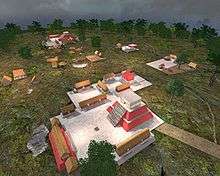 |
| Coba | Quintana Roo, Mexico | Coba is large site situated among five small lakes on a dry plain. The site is known for a network of 16 causeways linking it to neighbouring sites, the longest of which runs over 100 kilometres (62 mi) west to Yaxuna. The main phase of occupation of the city dates to the Late Classic through to the Early Postclassic, from about AD 700 to 1100.[9] |  |
| Copán | Copán Department, Honduras | Copán was the capital city of a major Classic period kingdom from the 5th to 9th centuries AD, when it was closely allied with Tikal. The city was located in the extreme southeast of the Mesoamerican cultural region, on the frontier with the Isthmo-Colombian cultural region, and was almost surrounded by non-Maya peoples. The city is best known for its elaborate sculptural style.[10] |  |
| Dos Pilas | Petén Department, Guatemala | Dos Pilas dates to the Late Classic Period, being founded by an offshoot of the Tikal dynasty in order to control trade routes in the Petexbatún region. It broke away from Tikal and became a vassal of Calakmul. It was a predator state from the beginning and the city gives an important glimpse into the great rivalries and political strife that characterised the Late Classic. Much of the history of Dos Pilas can now be reconstructed, with a level of detail that is almost unparalleled in the Maya area.[11] |  |
| Dzibilchaltun | Yucatán, Mexico | Dzibilchaltun was a large and important city in the far north of the Yucatán Peninsula, with its principal architecture dating to the Classic Period, although activity at the site continued into the Late Postclassic when the city's main temple was already in ruins.[12] |  |
| Iximche | Chimaltenango Department, Guatemala | Although short-lived, Iximche was the capital of the Kaqchikel highland kingdom at the time of the Spanish conquest of Guatemala and became the base of operations for the conquest of the highlands and Pacific coast until Spanish demands for tribute caused the Kaqchikels to break off their alliance and rebel. The Spanish then burned Iximche and moved their capital to nearby Tecpán Guatemala until frequent Kaqchikel raids forced them to move their colonial capital to what is now Ciudad Vieja near Antigua Guatemala. | 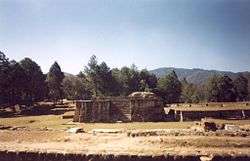 |
| Ixkun | Petén Department, Guatemala | Ixkun is a large site containing many unrestored mounds and ruins and is the best known archaeological site within the municipality of Dolores.[13] It was the capital of one of the four largest kingdoms in the upper Mopan Valley.[14] Stela 1 at Ixkun is one of the tallest stone monuments in the entire Petén Basin.[15] Although the main period of activity was during the Late Classic Period, the site was occupied from the Late Preclassic right through to the Postclassic Period. |  |
| Kaminaljuyu | Guatemala Department, Guatemala | Kaminaljuyu was founded in the Middle Preclassic and emerged as an important city in the Late Preclassic and dominated the entire Maya Highlands. It declined at the end of the Preclassic and was taken over by a new Maya group in the Early Classic with strong contacts with central Mexico. Occupation at Kaminaljuyu extended into the Late Classic.[16] |  |
| Mayapan | Yucatán, Mexico | Mayapan was an important fortified city with a densely occupied area within the city walls. The principal pyramid at Mayapan was modelled after the main pyramid at Chichen Itza. The city was the most important site in Yucatán for a period of about 250 years during the Postclassic Period, with the earliest structures dating to the 12th century AD.[17] |  |
| El Mirador | Petén Department, Guatemala | El Mirador was an enormous Late Preclassic city although construction apparently began in the Middle Preclassic and some level of occupation continued into the Classic Period. The city included some very large triadic pyramids and covered an area similar to that of Classic Period Tikal.[18] |  |
| Naachtun | Petén Department, Guatemala | Naachtun is situated in the extreme north of Petén, in a central location between Tikal and Calakmul, the two great Classic Period Maya powers, both of which constantly influenced its politics. The hieroglyphic texts from the site cover almost the whole Classic Period from 504 to 761 AD, although the site was inhabited since the Preclassic.[19] | |
| Nakbe | Petén Department, Guatemala | Nakbe was an important city in the Middle Preclassic, with its principal phase of occupation lasting from about 1000 BC to 400 BC. The city is linked to neighbouring El Mirador by a Late Preclassic causeway. Nakbe appears to possess the earliest examples of Maya masonry architecture and of sacbe causeways.[20] | |
| Naranjo | Petén Department, Guatemala | Naranjo was the capital of a kingdom from the Early Classic through to the Late Classic and formed an important link in the trade routes running from the great city of Tikal to the Caribbean Sea. The earliest dated monuments at the site date to the late 5th century AD. The city became a vassal of Tikal's great rival Calakmul and was involved in a series of devastating wars.[21] | |
| Oxkintok | Yucatán, Mexico | Oxkintok was one of the first Maya states to develop in the northern lowlands, undergoing a process of rapid development in the Early Classic Period that gave rise to an important capital with inscribed stone monuments. The earliest dated monument dates to the late 5th century AD.[22] |  |
| Palenque | Chiapas, Mexico | Palenque is located in the foothills of the Chiapas highlands. The city became dominant over the western Maya lowlands during the Late Classic, and engaged in hostilities with its neighbour Toniná that eventually eclipsed it. Hieroglyphic inscriptions at Palenque document a dynastic sequence stretching from the 5th century AD through to the end of the 8th century. The site is best known for the Temple of the Inscriptions, the mortuary shrine containing the tomb of king K'inich Janaab' Pakal.[23] | |
| El Peru (also known as Waka') | Petén Department, Guatemala | El Perú was a major Classic Period ally of Calakmul in its wars against Tikal.[24] | 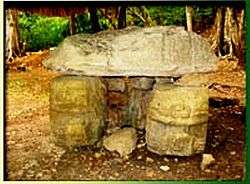 |
| Piedras Negras | Petén Department, Guatemala | Piedras Negras was the largest city in the region of the Usumacinta River and is known for its excellent quality Late Classic sculpted monuments. These well preserved inscriptions provided the first evidence that Maya texts described historical events. The site has a continuous series of texts running from the 7th century AD through to the 9th century.[25] |  |
| Quiriguá | Izabal Department, Guatemala | Quiriguá is a relatively small site that was founded by Tikal in the Early Classic in order to control the Motagua River trade route, important for the transport of jade and obsidian. Originally a vassal of Copán, the city rebelled and allied itself with Calakmul, after which it erected elaborate monuments in a style similar to that of its former overlord.[26] |  |
| Q'umarkaj | Quiché Department, Guatemala | Q'umarkaj (also known as Utatlán) was the Postclassic capital of the K'iche' Kingdom of Q'umarkaj at the time of the Spanish Conquest and was one of the most powerful Maya cities at that time, dominating the Guatemalan Highlands.[27] | 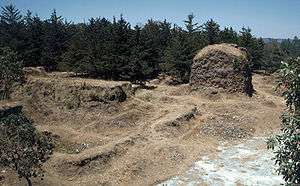 |
| San Bartolo | Petén Department, Guatemala | San Bartolo is a remote site in the Guatemalan rainforest and was only discovered in 2001. Most of the structures at the site date to the Late Preclassic and overlie older Middle Preclassic architecture, although the city was reoccupied in the Late Classic. San Bartolo possesses one of the most important Preclassic murals yet found.[28] |  |
| Tikal | Petén Department, Guatemala | Tikal was founded in the Late Preclassic but reached its greatest power in the Late Classic, when most of its great temples were constructed. The site was one of the most powerful kingdoms in Maya history and possesses a dynastic chronology that extends from about AD 100 through to the 9th century. A long-running rivalry between Tikal and Calakmul began in the 6th century, with each of the two cities forming its own network of mutually hostile alliances arrayed against each other in what has been likened to a long-running war between two Maya superpowers.[29] |  |
| Tulum | Quintana Roo, Mexico | Tulum is a Late Postclassic site situated on cliffs overlooking the Caribbean Sea and was probably occupied at the time of the Spanish Conquest. It is a small site with architecture in a style similar to that at the bigger cities of Chichen Itza and Mayapan. The site was probably founded to expand the coastal trade routes of the Yucatán Peninsula.[30] |  |
| Uxmal | Yucatán, Mexico | Uxmal was an important capital in the western Yucatán region, demonstrating architecture in the Puuc Maya style. The site reached its apogee in the Late to Terminal Classic from about AD 800–1000 and appears to have declined at the beginning of the Postclassic Period, although the exact length of occupation of the city is unknown.[31] |  |
| Yaxchilan | Chiapas, Mexico | In the Late Classic Period Yaxchilan was one of the most powerful Maya cities along the course of the Usumacinta, with Piedras Negras as its major rival.[32] Architectural styles in subordinate sites in the Usumacinta region demonstrate clear differences that mark a clear boundary between the two kingdoms.[32] Yaxchilan was a large center, important throughout the Classic era, and the dominant power of the Usumacinta River area. It dominated such smaller sites as Bonampak.[33] The site is particularly known for its well-preserved sculptured stone lintels set above the doorways of the main structures.[34] | 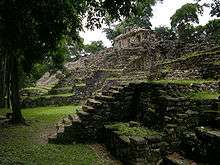 |
| Yaxha | Petén Department, Guatemala | Yaxha was a large city located upon the north shore of the lake of the same name. The city reached its maximum power in the Early Classic, when it was one of the largest capital cities in the Maya region; it was apparently allied with Tikal at that time. By the Late Classic its power had waned, perhaps linked to defeat by Calakmul or its allies.[35] | 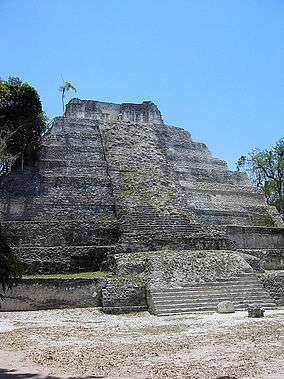 |
Alphabetical listing
A
| Site | Location | Photo |
|---|---|---|
| Abaj Takalik (see Takalik Abaj) | Retalhuleu Department, Guatemala[36] |  |
| Acanceh | Yucatán, Mexico[37] |  |
| Acanmul | Campeche, Mexico[38] |  |
| Actun Tunichil Muknal | Cayo District, Belize[39] | 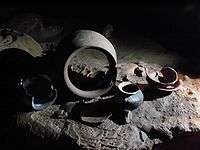 |
| Actuncan | Cayo District, Belize[40] | |
| El Aguacate | Petén Department, Guatemala[41] | |
| Aguas Calientes | Petén Department, Guatemala[42] | |
| Aguateca | Petén Department, Guatemala[43] |  |
| Ake | Yucatán, Mexico[37] |  |
| Akte | Petén Department, Guatemala[44] | |
| Almuchil | Campeche, Mexico[45] | |
| Altar de los Reyes | Campeche, Mexico[46] | |
| Altar de Sacrificios | Petén Department, Guatemala[47] | |
| Altun Ha | Belize District, Belize |  |
| La Amelia | Petén Department, Guatemala[48] |  |
| El Amparo | Chiapas, Mexico | |
| Anayte' | Chiapas, Mexico | |
| Anonal | Petén Department, Guatemala[49] | |
| Arroyo de Piedra | Petén Department, Guatemala[50] |
B
C
D
| Site | Location | Photo |
|---|---|---|
| Dos Pilas | Petén Department, Guatemala[71] |  |
| Dzehkabtun | Campeche, Mexico | |
| Dzekilna | Yucatán, Mexico | |
| Dzibanche | Quintana Roo, Mexico[72] |  |
| Dzibilchaltun | Yucatán, Mexico[37] |  |
| Dzibilnocac | Campeche, Mexico[37] |  |
| Dzibiltun | Campeche, Mexico |  |
| Dzilam | Yucatán, Mexico | |
| Dzitbalche | Campeche, Mexico | |
| Dzula | Quintana Roo, Mexico |
E
| Site | Location | Photo |
|---|---|---|
| Edzna | Campeche, Mexico[37] | |
| Ek' Balam | Yucatán, Mexico[37] | |
| Ekab (modern Cancun) | Quintana Roo, Mexico | |
| El Encanto (Chiapas) | Chiapas, Mexico | |
| El Encanto (Petén) | Petén Department, Guatemala[73] | |
| Colonia La Esperanza | Chiapas, Mexico |
F
| Site | Location | Photo |
|---|---|---|
| La Florida | Petén Department, Guatemala[74] | .jpg) |
| Flores (see Nojpetén) | Petén Department, Guatemala[75] |  |
G
| Site | Location | Photo |
|---|---|---|
| Guaquitepec | Chiapas, Mexico | |
| Gumarcaj (see Q'umarkaj) | Quiché Department, Guatemala[76] |  |
H
| Site | Location | Photo |
|---|---|---|
| Hacienda Hotzuc | Yucatán, Mexico | |
| Halakal | Yucatán, Mexico | |
| Halal | Yucatán, Mexico | |
| Haltunchon | Campeche, Mexico | |
| Los Higos | Copán Department, Honduras | |
| Hochob | Campeche, Mexico[37] |  |
| Holactun | Campeche, Mexico | |
| Holmul | Petén Department, Guatemala | |
| La Honradez[77] | Petén Department, Guatemala | |
| Holtun | Petén Department, Guatemala[78] | |
| Los Horcones | Chiapas, Mexico[79] |  |
| Hormiguero | Campeche, Mexico[37] |  |
| Huacutal | Petén Department, Guatemala | |
| Huntichmul | Yucatán, Mexico |  |
| Huntichmul II | Campeche, Mexico |  |
I
| Site | Location | Photo |
|---|---|---|
| Ichmac | Campeche, Mexico | |
| Ichmul | Yucatán, Mexico | |
| Ichpaatun | Quintana Roo, Mexico | |
| Ichpich | Campeche, Mexico |  |
| Ikil (Maya site) | Yucatán, Mexico | |
| Itsimte-Sacluk | Petén Department, Guatemala | |
| Itzamkanac | Campeche, Mexico | |
| Itzan | Petén Department, Guatemala[80] | |
| Itzimte-Bolonchen (see Bolonchen) | Campeche, Mexico | |
| Ixil | Yucatán, Mexico | |
| Iximche | Chimaltenango Department, Guatemala[81] | |
| Ixkun | Petén Department, Guatemala[82] |  |
| Ixlu | Petén Department, Guatemala[83] |  |
| Ixtelha | Chiapas, Mexico | |
| Ixtonton | Petén Department, Guatemala[84] |  |
| Ixtutz | Petén Department, Guatemala[85] |  |
| Izamal | Yucatán, Mexico[37] |  |
| Izapa | Chiapas, Mexico |  |
J
| Site | Location | Photo |
|---|---|---|
| Jacawitz (see Chitinamit) | Quiché Department, Guatemala | |
| Jaina Island | Campeche, Mexico[86] | |
| Jimbal | Petén Department, Guatemala[87] | |
| Jolja' | Chiapas, Mexico | |
| Jonuta | Tabasco, Mexico | |
| Joya de Cerén | La Libertad Department, El Salvador |  |
| La Joyanca | Petén Department, Guatemala[88] |
K
| Site | Location | Photo |
|---|---|---|
| Kabah | Yucatán, Mexico[37] | |
| Kalakmul (see Calakmul) | Campeche, Mexico[37] |  |
| Kaminaljuyu | Guatemala Department, Guatemala[89] |  |
| Kana | Quintana Roo, Mexico | |
| Kanki | Campeche, Mexico[37] | |
| Kantunil Kin | Quintana Roo, Mexico | |
| Kaxuinic | Orange Walk District, Belize | |
| Kayal | Campeche, Mexico | |
| Kinal | Petén Department, Guatemala[90] | |
| Kiuic | Yucatán, Mexico |  |
| Kohunlich | Quintana Roo, Mexico[37] | |
| Komchen | Yucatán, Mexico | |
| K'atepan | Huehuetenango Department, Guatemala[91] |  |
L
| Site | Location | Photo |
|---|---|---|
| Labna | Yucatán, Mexico[37] |  |
| Lacanha | Chiapas, Mexico | |
| El Lagartero | Chiapas, Mexico[92] |  |
| Laguna Perdida | Petén Department, Guatemala[93] | |
| Lagunita | Campeche, Mexico | |
| Lamanai | Orange Walk District, Belize |  |
| Lashtunich | Petén Department, Guatemala | |
| Loltun | Yucatán, Mexico[37] | |
| López Mateos | Chiapas, Mexico | |
| Louisville | Corozal District, Belize | |
| Lubaantun | Toledo District, Belize |  |
M
| Site | Location | Photo |
|---|---|---|
| Machaquila | Petén Department, Guatemala[94] | |
| Managua (Maya site) | Campeche, Mexico | |
| Maní | Yucatán, Mexico | |
| La Mar | Chiapas, Mexico | |
| Mario Ancona | Quintana Roo, Mexico | |
| Maxcanu | Yucatán, Mexico | |
| Mayapan | Yucatán, Mexico[37] |  |
| El Meco | Quintana Roo, Mexico[37] | |
| La Milpa | Orange Walk District, Belize | |
| Minanha | Cayo District, Belize | |
| El Mirador | Petén Department, Guatemala[95] |  |
| Miraflores | Chiapas, Mexico | |
| Mixco Viejo | Chimaltenango Department, Guatemala[96] | |
| Monte Alto | Escuintla Department, Guatemala[97] | |
| La Montura | Petén Department, Guatemala | |
| Mopila | Yucatán, Mexico | |
| Moral Reforma | Tabasco, Mexico | |
| Motul de San José | Petén Department, Guatemala[98] | |
| Mountain Cow | Cayo District, Belize | |
| La Muerta | Petén Department, Guatemala |  |
| Mulchic | Yucatán, Mexico | |
| Muluch Tsekal | Yucatán, Mexico | |
| La Muñeca | Campeche, Mexico | |
| Muyil | Quintana Roo, Mexico[37] |  |
N
| Site | Location | Photo |
|---|---|---|
| Naachtun | Petén Department, Guatemala[19] | |
| Naj Tunich | Petén Department, Guatemala[99] | |
| Nakbe | Petén Department, Guatemala[100] | |
| Nakum | Petén Department, Guatemala |  |
| Naranjo | Petén Department, Guatemala[101] | |
| La Naya | Petén Department, Guatemala | |
| Nebaj | Quiché Department, Guatemala[102] | |
| Nicolás Bravo | Quintana Roo, Mexico[72] | |
| Nim Li Punit | Toledo District, Belize |  |
| Nocuchich | Campeche, Mexico | 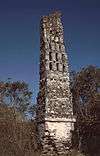 |
| Nohmul | Orange Walk District, Belize | |
| Nohpat | Yucatán, Mexico |
O
| Site | Location | Photo |
|---|---|---|
| Ojo de Agua | Campeche, Mexico | |
| Okop | Quintana Roo, Mexico | |
| Oxcutzcab | Yucatán, Mexico | |
| Oxkintok | Yucatán, Mexico[37] |  |
| Oxlahuntun | Chiapas, Mexico | |
| Oxpemul | Campeche, Mexico[103] | |
| Oxtankah | Quintana Roo, Mexico[61] |
P
Q
| Site | Location | Photo |
|---|---|---|
| "Site Q" (see La Corona) | Petén Department, Guatemala | |
| Quen Santo | Huehuetenango Department, Guatemala[115] | |
| Quiriguá | Izabal Department, Guatemala[116] |  |
| Q'umarkaj | Quiché Department, Guatemala[117] |  |
R
| Site | Location | Photo |
|---|---|---|
| El Resbalón | Quintana Roo, Mexico[72] | |
| El Retiro | Chiapas, Mexico | |
| Río Amarillo | Copán Department, Honduras | |
| Río Azul | Petén Department, Guatemala[118] | |
| Río Bec | Campeche, Mexico[103] |  |
| Río Michol | Chiapas, Mexico | |
| El Rosal (Maya site) |
S
| Site | Location | Photo |
|---|---|---|
| Sabacche | Yucatán, Mexico | |
| Sacchana | Chiapas, Mexico | |
| Sacnicte | Yucatán, Mexico | |
| Sacul | Petén Department, Guatemala[119] |  |
| Salinas de los Nueve Cerros | Alta Verapaz Department, Guatemala[120] | |
| San Andrés | La Libertad Department, El Salvador |  |
| San Bartolo | Petén Department, Guatemala |  |
| San Clemente | Petén Department, Guatemala[121] | |
| San Diego | Petén Department, Guatemala[122] | |
| San Gervasio | Quintana Roo, Mexico[37] |  |
| San Lorenzo (Campeche) | Campeche, Mexico | |
| San Lorenzo (Chiapas) | Chiapas, Mexico | |
| San Mateo Ixtatán | Huehuetenango Department, Guatemala[123] | 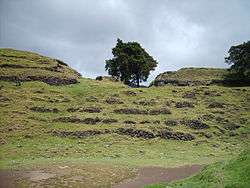 |
| San Pedro (Dzitbalche) | Campeche, Mexico | |
| Santa Elena Poco Uinic | Chiapas, Mexico | |
| Santa Rita Corozal | Corozal District, Belize | |
| Santa Rosa Xtampak | Campeche, Mexico[37] | |
| Santoton | Chiapas, Mexico | |
| Sayil | Yucatán, Mexico[37] |  |
| Seibal | Petén Department, Guatemala[124] | |
| Sihó | Yucatán, Mexico |  |
| Silvituc | Campeche, Mexico | |
| Simojovel | Chiapas, Mexico | |
| Sisilha | Campeche, Mexico | |
| La Sufricaya | Petén Department, Guatemala[125] |
T
| Site | Location | Photo |
|---|---|---|
| Tabi | Yucatán, Mexico | |
| El Tabasqueño | Campeche, Mexico[37] | 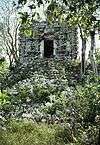 |
| Takalik Abaj | Retalhuleu Department, Guatemala[36] | 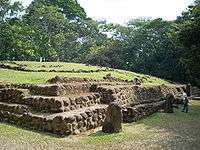 |
| Tamarindito | Petén Department, Guatemala | |
| Tancah | Quintana Roo, Mexico | |
| Tayasal | Petén Department, Guatemala[126] | |
| Tazumal | Santa Ana Department, El Salvador |  |
| Techoh | Yucatán, Mexico | |
| Telantunich | Quintana Roo, Mexico | |
| Teleman | Alta Verapaz Department, Guatemala | |
| El Temblor | Petén Department, Guatemala | |
| Tenam Puente | Chiapas, Mexico[37] |  |
| Tenam Rosario | Chiapas, Mexico | |
| Tikal | Petén Department, Guatemala[127] | 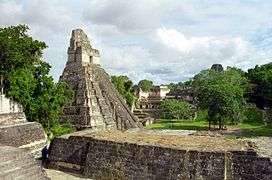 |
| Tila | Chiapas, Mexico | |
| El Tintal | Petén Department, Guatemala[128] | 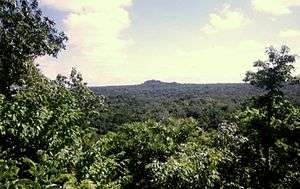 |
| Tohcok | Campeche, Mexico[37] |  |
| Tonalá | Chiapas, Mexico | |
| Toniná | Chiapas, Mexico[37] |  |
| Topoxté | Petén Department, Guatemala[129] |  |
| Tortuguero | Tabasco, Mexico | |
| Tres Islas | Petén Department, Guatemala[130] | |
| La Trinidad de Nosotros | Petén Department, Guatemala[131] | |
| Tulum | Quintana Roo, Mexico[37] |  |
| Tunkuyi | Campeche, Mexico | |
| Tzendales | Chiapas, Mexico | |
| Tzibanche | Quintana Roo, Mexico | |
| Tzocchen | Campeche, Mexico | |
| Tzum | Campeche, Mexico |
U
| Site | Location | Photo |
|---|---|---|
| Uaxactun | Petén Department, Guatemala[132] | |
| Uaymil | Campeche, Mexico[133] | |
| Ucanal | Petén Department, Guatemala[134] | |
| Uci | Yucatán, Mexico | |
| Uitzina | Yucatán, Mexico |  |
| Ukum | Yucatán, Mexico | |
| La Unión | Quintana Roo, Mexico[72] | |
| Uolantun | Petén Department, Guatemala | |
| Utatlan (see Q'umarkaj) | Quiché Department, Guatemala |  |
| Uxbenka | Toledo District, Belize | |
| Uxmal | Yucatán, Mexico[37] |  |
| Uxul | Campeche, Mexico |
W
| Site | Location | Photo |
|---|---|---|
| Waka' (see El Perú) | Petén Department, Guatemala[107] |  |
| Waxaktun (see Uaxactun) | Petén Department, Guatemala[132] | |
| Witzna | Petén Department, Guatemala |
X
| Site | Location | Photo |
|---|---|---|
| Xbalche | Campeche, Mexico |  |
| Xcalumkin | Campeche, Mexico[37] |  |
| Xcambo | Yucatán, Mexico |  |
| Xcaret | Quintana Roo, Mexico[37] | 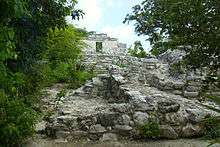 |
| X'Castillo | Yucatán, Mexico | |
| Xcocha | Campeche, Mexico | |
| Xcochkax | Campeche, Mexico | |
| Xcorralche | Yucatán, Mexico | |
| Xcucsuc | Campeche, Mexico | |
| Xculoc | Campeche, Mexico | |
| Xelha | Quintana Roo, Mexico[37] |  |
| Xicalango | Campeche, Mexico | |
| Xkalachetzimin | Campeche, Mexico | |
| Xkichmook | Yucatán, Mexico |  |
| Xkipche | Yucatán, Mexico | |
| Xkombec | Campeche, Mexico | |
| Xkukican | Yucatán, Mexico | |
| Xlapak | Yucatán, Mexico[37] | .jpg) |
| Xmakabatun | Petén Department, Guatemala | |
| Xnaheb | Toledo District, Belize | |
| Xnucbec | Campeche, Mexico |  |
| Xpuhil | Campeche, Mexico[37] |  |
| Xtampak (also known as Santa Rosa Xtampak) | Campeche, Mexico[37] | |
| Xtobo | Yucatán, Mexico | |
| Xul | Yucatán, Mexico | |
| Xultun | Petén Department, Guatemala[135] | |
| Xunantunich | Cayo District, Belize |  |
| Xupa | Chiapas, Mexico | |
| Xutilha | Petén Department, Guatemala[136] | |
| Xutixtiox (see Chutixtiox) | Quiché Department, Guatemala[69] |
Y
| Site | Location | Photo |
|---|---|---|
| Yaaxhom | Yucatán, Mexico | |
| Yakalmai | Campeche, Mexico | |
| Yalcabakal | Campeche, Mexico | |
| Yaltutud | Petén Department, Guatemala | |
| Yaxche-Xlabpak | Campeche, Mexico |  |
| Yaxchilan | Chiapas, Mexico[37] |  |
| Yaxcopoil | Yucatán, Mexico | |
| Yaxha | Petén Department, Guatemala[137] |  |
| Yaxuna | Yucatán, Mexico | |
| Yo'okop | Quintana Roo, Mexico | |
| Yula | Yucatán, Mexico |
Z
| Site | Location | Photo |
|---|---|---|
| Zacpeten | Petén Department, Guatemala[138] | |
| Zaculeu | Huehuetenango Department, Guatemala[139] | 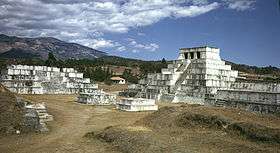 |
| El Zapote | Petén Department, Guatemala[140] | |
| Zapote Bobal | Petén Department, Guatemala[141] |  |
| El Zotz | Petén Department, Guatemala[142] |
See also
Notes
- ↑ The CMHI enumeration of sites with inscriptions and/or Maya artworks, as modified and revised by Riese (2004) lists over 430 sites.
- ↑ Witschey and Brown (2005)
- ↑ Sharer & Traxler 2006, pp.372-373.
- ↑ Sharer & Traxler 2006, pp.356-361.
- ↑ Sharer & Traxler 2006, p.364.
- ↑ Sharer & Traxler 2006, p.520.
- ↑ Sharer & Traxler 2006, pp.562-566.
- ↑ Sharer & Traxler 2006, pp.548-549.
- ↑ Sharer & Traxler 2006, p.556.
- ↑ Sharer & Traxler 2006, pp.333-341.
- ↑ Sharer & Traxler 2006, pp.383-387. Martin & Grube 2000, p.55.
- ↑ Sharer & Traxler 2006, p.550.
- ↑ Laporte & Mejía 2005, p. 5.
- ↑ Laporte 2005, p.202.
- ↑ Laporte & Torres 1994, p. 131.
- ↑ Sharer & Traxler 2006, p.195.
- ↑ Sharer & Traxler 2006, pp.592-599.
- ↑ Sharer & Traxler 2006, pp.252-253.
- 1 2 Mathews et al 2005, p.669.
- ↑ Sharer & Traxler 2006, p.210.
- ↑ Sharer & Traxler 2006, p.380.
- ↑ Sharer & Traxler 2006, p.301.
- ↑ Sharer & Traxler 2006, pp.451-472.
- ↑ Sharer & Traxler 2006, p.496.
- ↑ Sharer & Traxler 2006, p.424.
- ↑ Sharer & Traxler 2006, pp.351-354. Martin & Grube 2000, p.216. Miller 1999, pp.134–35.
- ↑ Sharer & Traxler 2006, pp.4, 621-623.
- ↑ Sharer & Traxler 2006, p.262.
- ↑ Sharer & Traxler 2006, pp.1, 302-311. Webster 2002, pp.168-9.
- ↑ Sharer & Traxler 2006, p.609.
- ↑ Sharer & Traxler 2006, pp.536-537.
- 1 2 Sharer & Traxler 2006, p.421.
- ↑ Coe 1999, p.125.
- ↑ Sharer & Traxler 2006, p.435.
- ↑ Sharer & Traxler 2006, p.375.
- 1 2 Ministerio de Cultura y Deportes. #1713.
- 1 2 3 4 5 6 7 8 9 10 11 12 13 14 15 16 17 18 19 20 21 22 23 24 25 26 27 28 29 30 31 32 33 34 35 36 37 38 39 40 41 42 43 44 45 46 47 48 49 50 CONACULTA 2007, pp.IV.3-4 (96-97).
- ↑ Awe et al 2005, p.223.
- ↑ LeCount 2004, p.27.
- ↑ Ministerio de Cultura y Deportes. #332.
- ↑ Ministerio de Cultura y Deportes. #367.
- ↑ Ministerio de Cultura y Deportes. #354.
- ↑ Moriarty 2005, p.444.
- ↑ Andrews 1984, 1990, p.8.
- ↑ Pharo 2014, p. 97.
- ↑ Ministerio de Cultura y Deportes. #363.
- ↑ Ministerio de Cultura y Deportes.
- ↑ Ministerio de Cultura y Deportes. #370.
- ↑ Ministerio de Cultura y Deportes. #355.
- ↑ Ministerio de Cultura y Deportes. #1115.
- ↑ Ministerio de Cultura y Deportes. #1210.
- ↑ Ministerio de Cultura y Deportes. #2.
- ↑ Ministerio de Cultura y Deportes. #427.
- ↑ Moriarty 2005, p.443.
- ↑ Ministerio de Cultura y Deportes. #345.
- ↑ Ministerio de Cultura y Deportes. #368.
- ↑ Ichikawa et al 2009, pp.502, 505.
- ↑ Garrido 2009, p.1011.
- ↑ Ministerio de Cultura y Deportes. #1651.
- 1 2 Esparza Olguín and Pérez Gutiérrez 2009, p. 1.
- ↑ Moriarty 2005, p.441.
- ↑ Ministerio de Cultura y Deportes. #53.
- ↑ Ministerio de Cultura y Deportes. #21.
- 1 2 CONACULTA 2007, p.IV.5 (98).
- ↑ Ministerio de Cultura y Deportes. #1005.
- ↑ Ministerio de Cultura y Deportes. #2126.
- ↑ Ministerio de Cultura y Deportes. #364.
- 1 2 Adams 1996, p. 318.
- ↑ Amaroli and Amador 2003, p. 2.
- ↑ Ministerio de Cultura y Deportes. #361.
- 1 2 3 4 Esparza Olguín and Pérez Gutiérrez 2009, p. 15.
- ↑ Ministerio de Cultura y Deportes. #177.
- ↑ Ministerio de Cultura y Deportes. #232.
- ↑ Ministerio de Cultura y Deportes. #129.
- ↑ Ministerio de Cultura y Deportes. Listed as Utatlan (Qumarkaaj), #1008.
- ↑ Muñoz Cosme et al 2010, p. 378.
- ↑ Ministerio de Cultura y Deportes. #140.
- ↑ García-Des Lauriers, undated.
- ↑ Ministerio de Cultura y Deportes. #192.
- ↑ Ministerio de Cultura y Deportes. #715.
- ↑ Ministerio de Cultura y Deportes. #17.
- ↑ Ministerio de Cultura y Deportes. #136.
- ↑ Ministerio de Cultura y Deportes. #18.
- ↑ Ministerio de Cultura y Deportes. #7.
- ↑ Benavides C. 2005, p.22.
- ↑ Ministerio de Cultura y Deportes. #179.
- ↑ Ministerio de Cultura y Deportes. #204.
- ↑ Ministerio de Cultura y Deportes. #1306.
- ↑ Ministerio de Cultura y Deportes. #412.
- ↑ Wölfel and Frühsorge 2008, pp. 86-87
- ↑ INAH 2015.
- ↑ Ministerio de Cultura y Deportes. #198.
- ↑ Ministerio de Cultura y Deportes. #215.
- ↑ Ministerio de Cultura y Deportes. #288.
- ↑ Ministerio de Cultura y Deportes. #696.
- ↑ Ministerio de Cultura y Deportes. #1111.
- ↑ Ministerio de Cultura y Deportes. #313.
- ↑ Ministerio de Cultura y Deportes. #213.
- ↑ Ministerio de Cultura y Deportes. #317.
- ↑ Ministerio de Cultura y Deportes. #400.
- ↑ Ministerio de Cultura y Deportes. #905.
- ↑ Ministerio de Cultura y Deportes. #1220.
- ↑ Ministerio de Cultura y Deportes. #199.
- ↑ Ministerio de Cultura y Deportes. #202.
- 1 2 Ministerio de Cultura y Deportes. #229.
- ↑ Ministerio de Cultura y Deportes. #210.
- ↑ Ministerio de Cultura y Deportes. #404.
- ↑ Ministerio de Cultura y Deportes. #162.
- ↑ Ministerio de Cultura y Deportes. #194.
- ↑ Ministerio de Cultura y Deportes. #655.
- ↑ Ministerio de Cultura y Deportes. #209.
- ↑ Ministerio de Cultura y Deportes. #359.
- ↑ Ministerio de Cultura y Deportes. #1466.
- ↑ Ministerio de Cultura y Deportes. #1555.
- ↑ Ministerio de Cultura y Deportes. #1008.
- ↑ Ministerio de Cultura y Deportes. #413.
- ↑ Ministerio de Cultura y Deportes. #16, 30-33.
- ↑ Ministerio de Cultura y Deportes. #435.
- ↑ Ministerio de Cultura y Deportes. #155.
- ↑ Ministerio de Cultura y Deportes. #347.
- ↑ Ministerio de Cultura y Deportes. #1469.
- ↑ Ministerio de Cultura y Deportes. #366.
- ↑ Foley 2007.
- ↑ Ministerio de Cultura y Deportes. #131.
- ↑ Ministerio de Cultura y Deportes. #180.
- ↑ Ministerio de Cultura y Deportes. #267.
- ↑ Ministerio de Cultura y Deportes. #156.
- ↑ Ministerio de Cultura y Deportes. #352.
- ↑ Moriarty 2005, p.445.
- 1 2 Ministerio de Cultura y Deportes. #181.
- ↑ Ministerio de Cultura y Deportes. #423.
- ↑ Ministerio de Cultura y Deportes. #411.
- ↑ Ministerio de Cultura y Deportes. #322.
- ↑ Ministerio de Cultura y Deportes. #159.
- ↑ Rice and Rice 1997, p. 567.
- ↑ Ministerio de Cultura y Deportes. #1420.
- ↑ Estrada-Belli and Foley 2004, p.843.
- ↑ Ministerio de Cultura y Deportes. #207.
- ↑ Ministerio de Cultura y Deportes. #314.
External links
The long-term research project Text Database Dictionary of Classic Mayan is working on a list of Archaeological Sites with Maya Inscriptions that is constantly growing. The list is sorted by site name, and primarily encompasses the archaeological sites in Mesoamerica where Maya hieroglyphic inscriptions have been discovered and verifiably documented over the course of archaeological survey and excavations.
References
- Adams, Richard E.W. (1996). Prehistoric Mesoamerica (Revised ed.). Norman: University of Oklahoma Press. ISBN 0-8061-2834-8. OCLC 22593466.
- Amaroli, Paul; and Fabio E. Amador (2003) "Los Límites de Cihuatán: Reconocimiento arqueológico para determinar la extensión de la antigua ciudad". San Salvador, El Salvador: Fundación Nacional de Arqueología de El Salvador. Retrieved on 11 April 2016.
- Andrews, George F. (1990) [1984]. "Architectural survey Puuc region : 1984 field season. Volume I" (PDF). Austin, Texas: University of Texas. OCLC 758390353. Retrieved 2012-01-15.
- Awe, Jaime J.; Cameron Griffith; Sherry Gibbs (2005). "Cave Stelae and Megalithic Monuments in Western Belize". In James E. Brady and Keith M. Prufer. In the Maw of the Earth Monster: Mesoamerican Ritual Cave Use. The Linda Schele series in Maya and pre-Columbian studies. Austin, Texas: University of Texas Press. pp. 223–248. ISBN 978-0-292-70586-9. OCLC 57691801.
- Benavides C., Antonio (2005). "Campeche Archaeology at the Turn of the Century" (PDF). Anthropological Notebooks. Slovene Anthropological Society (11): 13–30. ISSN 1408-032X. OCLC 243599738. Retrieved 2012-01-13.
- Coe, Michael D. (1999). The Maya. Ancient peoples and places series (6th edition, fully revised and expanded ed.). London and New York: Thames & Hudson. ISBN 0-500-28066-5. OCLC 59432778.
- CONACULTA (2007). "Diagnóstico de infraestructura cultural" (PDF) (in Spanish). Mexico City: Consejo Nacional para la Cultura y las Artes. Retrieved 2010-06-10.
|chapter=ignored (help) - Esparza Olguín, Octavio Q.; Vania E. Pérez Gutiérrez (Winter 2009). "Archaeological and Epigraphic Studies in Pol Box, Quintana Roo" (PDF). The PARI Journal. San Francisco, California, USA: Pre-Columbian Art Research Institute. IX (3): 1–16. ISSN 1531-5398. Retrieved 2012-12-25.
- Estrada-Belli, Francisco; Jennifer Foley (2004). "Arqueología e historia de enlaces geo-políticos: El Clásico Temprano en La Sufricaya" [The archaeology and history of geopolitical contacts: The Early Classic in La Sufricaya] (PDF). XVII Simposio de Investigaciones Arqueológicas en Guatemala, 2003 (edited by J.P. Laporte, B. Arroyo, H. Escobedo and H. Mejía (in Spanish). Guatemala City, Guatemala: Museo Nacional de Arqueología y Etnología: 843–851. Retrieved 2012-03-03.
- Foley, Jennifer (2007). "Correlating Archaeological and Epigraphic Evidence at La Sufricaya, Holmul, Petén". The Foundation Granting Department: Reports Submitted to FAMSI. Foundation for the Advancement of Mesoamerican Studies, Inc. (FAMSI). Retrieved 2012-03-03.
- García-Des Lauriers, Claudia (n.d.). "Proyecto Arqueológico Los Horcones (PALH): La presencia teotihuacana el la Costa de Chiapas" (PDF) (in Spanish). Mexico City, Mexico: Instituto Nacional de Antropología e Historia. Retrieved 2016-01-28.
- Garrido, José Luis (2009). "Reconociendo Nueve Cerros: Instrumentos sonoros procedentes del área." (PDF). XXII Simposio de Investigaciones Arqueológicas en Guatemala, 2008 (edited by J.P. Laporte, B. Arroyo and H. Mejía) (in Spanish). Guatemala City, Guatemala: Museo Nacional de Arqueología y Etnología: 1008–1020. Retrieved 2012-11-10.
- Ichikawa, Akira; hione Shibata; Masakage Murano (2009). "El Preclásico Tardío en Chalchuapa: Resultados de las investigaciones de la Estructura 5 en el Parque Arqueológico Casa Blanca" [The Late Preclassic in Chalchuapa: Results of the excavations of Structure 5 in the Casa Blanca Archaeological Park] (PDF). XXII Simposio de Investigaciones Arqueológicas en Guatemala, 2008 (edited by J.P. Laporte, B. Arroyo and H. Mejía) (in Spanish). Guatemala City, Guatemala: Museo Nacional de Arqueología y Etnología: 502–515. Retrieved 2012-03-03.
- INAH (10 June 2015). "Zona Arqueológica de Lagartero" (in Spanish). Mexico City, Mexico: Instituto Nacional de Antropología e Historia. Archived from the original on 2016-01-28. Retrieved 2015-01-28.
- Guatemala (Map) (3rd ed.). 1:500000. International Travel Maps. ITMB Publishing. 1997. ISBN 0-921463-64-2.
- Guatemala (Map) (5th ed.). 1:470000. International Travel Maps. ITMB Publishing. 2005. ISBN 1-55341-230-3.
- Laporte, Juan Pedro (2005). "Terminal Classic Settlement and Polity in the Mopan Valley, Petén, Guatemala". In Arthur A. Demarest, Prudence M. Rice and Don S. Rice (eds.). The Terminal Classic in the Maya lowlands: Collapse, transition, and transformation. Boulder: University Press of Colorado. pp. 195–230. ISBN 0-87081-822-8. OCLC 61719499.
- Laporte, Juan Pedro; Héctor E. Mejía (2005). "Ixkun, Dolores, Petén: Una introducción." (PDF online publication). Ixkun, Petén, Guatemala: Exploraciones en una ciudad del alto Mopan, 1985-2005 (edited by J.P. Laporte and H. Mejía) (in Spanish). Guatemala: Atlas Arqueológico de Guatemala, Dirección General del Patrimonio Cultural y Natural, Ministerio de Cultura y Deportes. pp. 1–12. Retrieved 2010-12-05.
- Laporte, Juan Pedro; Carlos Rolando Torres (1994). "Los señoríos del Sureste de Petén." (PDF). I Simposio de Investigaciones Arqueológicas en Guatemala, 1987 (edited by J.P. Laporte, H. Escobedo and S. Villagrán) (in Spanish). Guatemala: Museo Nacional de Arqueología y Etnología. pp. 112–134. Retrieved 2010-12-07.
- LeCount, Lisa J. (2004). "Looking for a Needle in a Haystack: The Early Classic Period at Actuncan, Cayo District" (PDF). Research Reports in Belizean Archaeology. Belize: Institute of Archaeology, National Institute of Culture and History (NICH). 1: 27–36. OCLC 434569959. Retrieved 2012-01-13.
- Martin, Simon; Nikolai Grube (2000). Chronicle of the Maya Kings and Queens: Deciphering the Dynasties of the Ancient Maya. London and New York: Thames & Hudson. ISBN 0-500-05103-8. OCLC 47358325.
- Mathews, Peter (n.d.). "Site Names and Codes". Who's Who in the Classic Maya World. Foundation for the Advancement of Mesoamerican Studies, Inc.
- Mathews, Peter; Kathryn Reese-Taylor; Marcelo Zamora; Alexander Parmington (2005). "Los monumentos de Naachtun, Petén" (PDF). XVIII Simposio de Investigaciones Arqueológicas en Guatemala, 2004 (edited by J.P. Laporte, B. Arroyo and H. Mejía) (in Spanish). Guatemala City: Museo Nacional de Arqueología y Etnología: 669–672. Retrieved 2012-01-13.
- Miller, Mary Ellen (1999). Maya Art and Architecture. London and New York: Thames & Hudson. ISBN 0-500-20327-X. OCLC 41659173.
- Ministerio de Cultura y Deportes. "Base de Datos Sitios Arqueológicos" (PDF) (in Spanish). Guatemala: Ministerio de Cultura y Deportes. Archived from the original (PDF) on 2012-05-26. Retrieved 2010-06-10.
- Moriarty, Matthew D. (2005). "Entre el centro y la periferia en la tierra de los Señores "Ik": Investigaciones recientes en sitios satélites de Motul de San José, Petén" (PDF online publication). XVIII Simposio de Investigaciones Arqueológicas en Guatemala, 2004 (edited by J.P. Laporte, B. Arroyo and H. Mejía) (in Spanish). Museo Nacional de Arqueología y Etnología, Guatemala. pp. 440–454. Retrieved 2012-01-15.
- Muñoz Cosme, Gaspar; Nuria Matarredona Desantes; Beatriz Martín Domínguez; Manuel May Castillo (2010). "Arquitecturas Olvidadas: Las Expediciones Científicas como Método de Investigación del Patrimonio en Peligro" (PDF). Arché (Journal of the Instituto Universitario de Restauración del Patrimonio de la Universidad Politécnica de Valencia (in Spanish). Valencia, Spain: Editorial de la Universitat Politècnica de València (4-5): 373–380. ISSN 1887-3960. OCLC 311510079. Retrieved 2012-12-26.
- Pharo, Lars Kirkhusmo (2014). "The Long Count Calendar of the Classic Maya Civilization". The ritual practise of time: philosophy and sociopolitics of Mesoamerican calendars. Leiden, Netherlands: Brill. ISBN 978-90-04-25235-6. OCLC 854857944.
- Pugh, Timothy; Prudence M. Rice (1997). J.P. Laporte and H. Escobedo, ed. "Arquitectura estilo Mayapan y evidencias de organización dual en el sitio Postclásico de Zacpeten, Petén." (PDF). Simposio de Investigaciones Arqueológicas en Guatemala, 1996 (in Spanish). Guatemala City, Guatemala: Museo Nacional de Arqueología y Etnología. X: 567–580. Retrieved 2012-12-26.
- Riese, Berthold (2004). "Abkürzungen für Maya-Ruinenorte mit Inschriften" (PDF). Wayeb Notes (in German). European Association of Mayanists. 8. ISSN 1379-8286. Retrieved 2010-06-07.
- Sharer, Robert J.; Loa P. Traxler (2006). The Ancient Maya (6th (fully revised) ed.). Stanford, CA: Stanford University Press. ISBN 0-8047-4817-9. OCLC 57577446.
- Webster, David L. (2002). The Fall of the Ancient Maya: Solving the Mystery of the Maya Collapse. London: Thames & Hudson. ISBN 0-500-05113-5. OCLC 48753878.
- Witschey, Walter R.T.; Clifford T. Brown (2005). "The Electronic Atlas of Ancient Maya Sites" (PDF). Retrieved 2010-06-05.
- Wölfel, Ulrich; Lars Frühsorge (August 2008). "Archaeological Sites near San Mateo Ixtatán: Hints at Ethnic Plurality". Mexicon. Mexicon. 30 (4): 86–93. JSTOR 23759262. (subscription required)








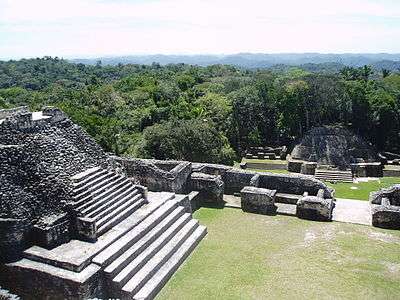
.jpg)

